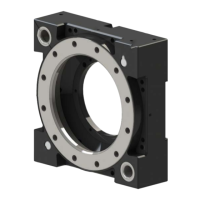Quick Change Installation and Operation Manual
Document #9620-20-E-ED15-04
Pinnacle Park • 1031 Goodworth Drive • Apex, NC 27539 USA • Tel: 919.772.0115 • Fax: 919.772.8259 • www.ati-ia.com • Email: info@ati-ia.com
E-5
4. Maintenance
Once installed the operation of the servo modules is generally trouble free. The modules are not designed to be eld
serviced as all point-to-point wiring connections are soldered. Component replacement is limited to the V-ring seal
on the Master.
DANGER: This module has a voltage of 50 V or greater, NO contact should be attempted
before removing power. This especially includes separation or insertion of the mating
connectors or any contact with the Tool Changer or its components. Arcing and damage will
occur if this is not observed. Remove power before attaching, disconnecting any cables or
attempting any maintenance of Tool Changer.
WARNING: Do not perform maintenance or repair on Tool Changer or modules unless the
Tool is safely supported or docked in the tool stand and all energized circuits (e.g., electrical,
air, water, etc.) have been turned off. Injury or equipment damage can occur with Tool not
docked and energized circuits on. Dock the Tool safely in the tool stand and turn off all
energized circuits before performing maintenance or repair on Tool Changer or modules.
If the Tool Changer is being used in dirty environments (e.g., welding or deburring applications), care should be
taken to limit the exposure of the Tool Changer. Idle Tool assemblies should be covered to prevent debris from
settling on the mating surface. Also, the Master assembly should be exposed for only a short period of time during
Tool change and down time.
Under normal conditions, no special maintenance is necessary however it is recommended that periodic inspections
be performed to assure long-lasting performance and to assure that unexpected damage has not occurred. Perform
the following visual inspection monthly:
• Inspect mounting fasteners to verify they are tight and if loose, then tighten to the proper torque.
• Cable connections should be inspected during maintenance periods to ensure they are secure. Loose
connections should be cleaned and re-tightened as appropriate. Inspect cable sheathing for damage, repair or
replace damaged cabling. Loose connections or damaged cabling are not expected and may indicate improper
routing and/or strain relieving.
• Inspect the Master and Tool pin blocks for any pin damage, debris or darkened pins. Refer to Section4.1—Pin
BlockInspectionandCleaning.
• Inspect V-ring seals for wear, abrasion, and cuts. If worn or damaged, replace. Refer to Section5.2.1—V-ring
SealReplacement.

